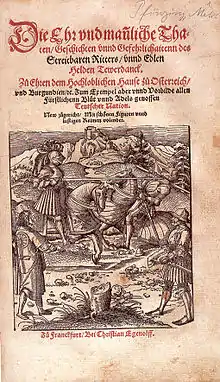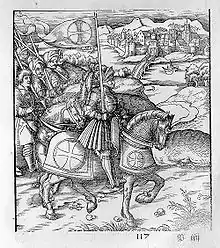Theuerdank
Theuerdank (Teuerdank, Tewerdanck, Teuerdannckh) is a poetic work composed by the Holy Roman Emperor, Maximilian I, (1486-1519) in German which tells the fictionalised and romanticised story of his journey to marry Mary of Burgundy in 1477. The published poem was accompanied by 118 woodcuts designed by the artists Leonhard Beck, Hans Burgkmair, Hans Schäufelein and others.[1] Its newly designed blackletter typeface was influential.


The full title in the first (1517) edition is Die geverlicheiten vnd einsteils der geschichten des loblichen streytparen vnd hochberümbten helds vnd ritters herr Tewrdannckhs ("The adventures and part of the stories of the praiseworthy, valiant and most famous hero and knight, lord Teuerdank").[2]
Background
Maximilian I, and his father Frederick III, were part of what was to become a long line of Holy Roman Emperors from the House of Habsburg. Maximilian was elected King of the Romans in 1486 and succeeded his father on his death in 1493.
During his reign Maximilian commissioned a number of humanist scholars and artists to assist him in completing a series of projects, in different art forms, intended to glorify for posterity his life and deeds and those of his Habsburg ancestors.[3][4] He referred to these projects as Gedechtnus ("memorial"),[4][5] and included a series of stylised autobiographical works, of which Theuerdank was one, the others being the poem Freydal and the chivalric novel Weisskunig.[3]
Composition and publication
Published in 1517, Theuerdank was probably written by Maximilian himself.[6] It may have been written either by Maximilian's chaplain, Melchior Pfintzing,[7] or his secretary, Marx Treitzsauerwein, albeit under Maximilian's close direction.[8] Giulia Bartrum states instead that "the text was composed and versified by Sigismund von Dietrichstein and Marx Treitzsauerwein. It was edited and prepared for publication" by Pfintzing, and the text was finished by 1514.[1]
The first 1517 edition was small, with most copies expensively printed on vellum for distribution to German princes and other dignitaries and close associates of Maximilian. A larger second edition followed in 1519. There were nine original editions in all, the last published in 1693.[9] Modern facsimile editions include one by Taschen. The Austrian National Library has manuscript texts and a proof edition with the woodcuts,[1] and some preparatory drawings by the artists survive.
There were still relatively few printed books in German when Theuerdank was first published. A new typeface for the work, designed by Vinzenz Rockner, had considerable influence on the development of the fraktur style.[10]
Content
"Theuerdank" is the name of the main protagonist in the work. The name may be translated as "noble or knightly thought".[11] Drawing on Arthurian romances,[6] it tells the fictionalised story, in romanticised verse, of Maximilian (as Theuerdank) travelling to the Duchy of Burgundy in 1477 to marry his bride-to-be, Mary of Burgundy, and the subsequent eight years of his life as ruler of the Duchy.[8][12] In the story, Theuerdank is a young prince who, after many trials and tribulations, succeeds in rescuing princess Ehrenreich but must go on a Crusade before being permitted to marry her.[8]
Illustrations
Of the 118 woodcut illustrations, Beck designed 77, and also adjusted those by others when Maximilian requested changes, which was very often – over half of the woodcuts show significant changes between the 1517 and 1519 editions, partly because he had also changed the text. Hans Schäufelein designed 20, Burgkmair, 13, with others by Wolf Traut, Hans Weiditz and Erhard Schön. A few remain unattributed.[13]
Jost de Negker, the top blockcutter of the period, was the main blockcutter, with his assistants, and was paid 4 gulden per block as well as an unknown retainer fee, whereas the artists only received 2 gulden for the designs for 3 prints, although this was much quicker work.[14] A long letter Negker wrote to Maximilian in 1512 survives, dealing with his fee and the arrangements, and Giulia Bartrum says that the "Imperial commissions enabled the block-cutter and printer Jost de Negker to raise the status of his profession to an unprecedentedly high level."[15]
References
- Bartrum, 147
- facsimile edition: digitale-sammlungen.de. Title of the 1553 edition: Die Ehr und männliche Thaten / Geschichten unnd Gefehrlichaitenn des Streitbaren Ritters / unnd Edlen Helden Tewerdanck "The honourable and manly deeds, stories and adventures of the valiant knight and noble lord Teuerdank (Frankfurt, Christian Egenolff, 1553).
- Watanabe-O'Kelly, Helen (12 June 2000). The Cambridge History of German Literature. Cambridge University Press. p. 94. ISBN 978-0-521-78573-0.
- Westphal, Sarah (20 July 2012). "Kunigunde of Bavaria and the 'Conquest of Regensburg': Politics, Gender and the Public Sphere in 1485". In Emden, Christian J.; Midgley, David (eds.). Changing Perceptions of the Public Sphere. Berghahn Books. p. 35. ISBN 978-0-85745-500-0.
- Kleinschmidt, Harald (January 2008). Ruling the Waves: Emperor Maximilian I, the Search for Islands and the Transformation of the European World Picture C. 1500. Antiquariaat Forum. p. 162. ISBN 978-90-6194-020-3.
- Braden K. Frieder (1 January 2008). Chivalry & the Perfect Prince: Tournaments, Art, and Armor at the Spanish Habsburg Court. Truman State Univ Press. p. 152. ISBN 978-1-935503-32-3.
- Julie Gardham (February 2005). "Maximilian I and Melchior Pfintzing: Teuerdank". University of Glasgow Special Collections. Retrieved 1 October 2015.
- Jean Berenger (22 July 2014). A History of the Habsburg Empire 1273-1700. Routledge. p. 121. ISBN 978-1-317-89570-1.
- Bartrum, 147-148
- World Digital Library, Library of Congress
- Edith A. Wright, "The Teuerdank of Emperor Maximilian", The Boston Public Library Quarterly 10 (1958), p. 137. Pfintzing himself suggests that the name should be taken as indicating "that the youth had given all his thoughts to knightly matters". While the personal name Teuerdank (teuer "dear" + dank "thought") is not attested in actual use, it is a plausible formation, dank "thought" being a well-attested element in German personal names (Förstemann 1856, 1149), and tiur "dear" is also attested, but phonetically indistinguishable from tiur "deer" (Förstemann 1856, 337).
- Martin Biddle; Sally Badham (2000). King Arthur's Round Table: An Archaeological Investigation. Boydell & Brewer. p. 470. ISBN 978-0-85115-626-2.
- Parshall, 208; Bartrum, 147
- Parshall, 207-208; Bartrum, 147
- Bartrum, 130
Bibliography
| Wikimedia Commons has media related to Theuerdank. |
